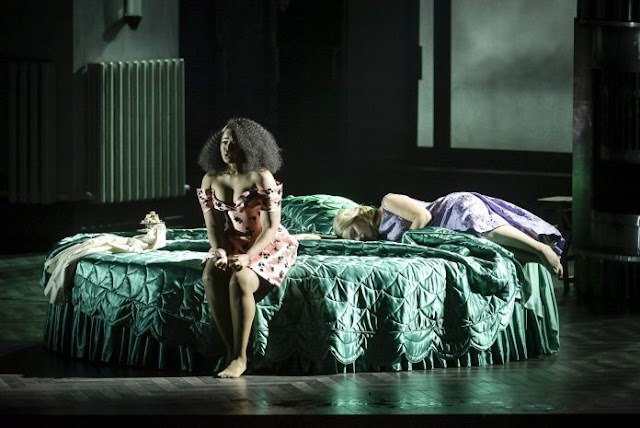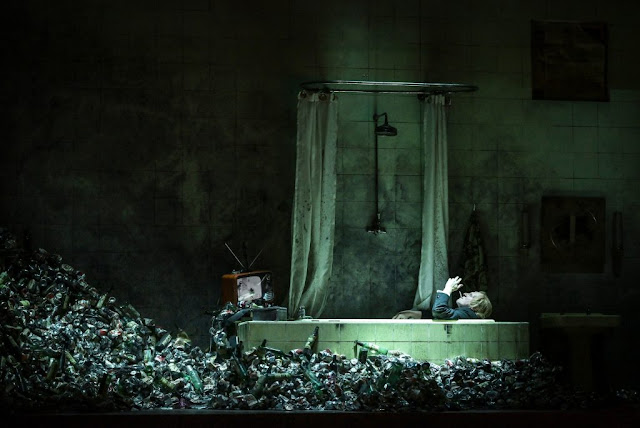 |
| Handel: Semele – Pretty Yende, Niamh O’Sullivan (Photo: Vincent Pontet) |
Handel: Semele; Pretty Yende, Ben Bliss, Alice Coote, Brindley Sherratt, director: Oliver Mears, conductor: Christian Curnyn; Royal Opera House
Reviewed 15 July 2025
A disappointing account of the title role alongside a misguided attempt at updating and relevance, mean Oliver Mear’s heavy handed production never quite comes alive
Handel’s later oratorios suggest that he was thinking dramatically, but whether he ever considered the works on stage is a moot point. We have little or no record of his thinking on these matters, no long correspondences with his librettists. But oratorios like Semele, Hercules and Susanna suggest he was thinking beyond a simple biblical story. The libretto to Jephtha owes as much to Greek drama as it does to the Bible, and how we would love to have a sample of Handel’s discussions with librettist Thomas Morell about that. And then Theodora, though a religious subject, was based on a romantic novel!
But there is no doubt that these works present problems on the modern operatic stage. There are moments when Handel forgets about the on-going drama and concentrates on something more abstract. The large-scale choruses in both Semele and Susanna contrast strongly with the lighter character of the rest of the drama.
When Handel’s Semele was first performed, his contemporaries viewed it as a possible satire on the relationship between King George II and his mistress, Lady Yarmouth, and I imagine that Congreve’s original libretto, written for John Eccles in 1706 had a similar intent. There is a lightness to much of Handel’s writing in Semele and the most successful stagings of the work that I have seen have not taken themselves too seriously.
At Covent Garden, having giving us an intensely serious version of Handel’s Jephtha with a radical subversion of the ending in 2023 [see my review], Oliver Mears returned to Handelian oratorio with Semele given a similarly highly serious makeover. We caught the performance at the Royal Opera House on 15 July 2025, when Christian Curnyn conducted with Pretty Yende as Semele, Ben Bliss as Jupiter, Alice Coote as Juno, Brindley Sherratt as Cadmus and Somnus, Carlo Vistoli as Athamas, Niamh O’Sullivan as Ino, and Marianna Hovanisyan as Iris. Designs were by Annemarie Woods with movement by Sarah Fahie. This was a co-production with Théâtre des Champs-Élysées where the production debuted earlier this year with the same cast (and where the pictures were taken).
 |
| Handel: Semele – Brindley Sherratt (Photo: Vincent Pontet) |
This was a highly serious take on the story, and though there were comic moments, Mears’ intentions were to tell a remarkably disturbing story. Set loosely in the 1960s, the story took place in the very grand mansion inhabited by Jove and Juno (Ben Bliss and Alice Coote), where Cadmus (Brindley Sherratt) and his people are now servants. Jove’s intentions are distinctly controlling, and his transactional relationship with Semele (Pretty Yende) ends in her incineration, done in a way that Mears suggests is a cycle, gone through endlessly. Many of Juno’s scenes were comic, how could they not be, but there was little comedy or pastoral delight in the relations between Semele and Jupiter. At the end, as the assembled ‘populace’ watched Semele’s incineration, Ino (Niamh O’Sullivan) became highly disturbed whilst Athmas (Carlo Vistoli) went mad.
Mears needed too much stage business to tell his story and the highly detailed narrative in Act One was hardly clear with much of the act making little dramatic sense. This is a tricky act to bring off at the best of times, and it was only at the end when we saw Semele’s incineration that things became clear. Having the Gods present, rather than indicating their will through signs and portents, and reducing the rest of the cast to the status of servants only served to weaken the drama further. And even by the end of Act One, it wasn’t really clear who these people were
Annemarie Woods’ designs included a drop curtain that we gradually realised was the grill from the incinerator. The complex set with its large foyer space that doubled for Cadmus’ temple and Jupiter’s palace meant that the other scenes took place in smaller inserts, requiring stage time, so we saw rather toom much of the drop curtain and too many scenes played out in front of it.
Movement director Sarah Fahie had worked hard on the choruses. The show used just the chorus and four actors, and certainly the choruses were filled with movement yet too often it felt as if this movement was there to fill up time rather than being part of a dramatic whole. And at the end of Act Two, Semele and Ino put on a record which they sing to, with the chorus delivering their parts from the pit. A cop-out if ever there was one.
All this might have held together if Pretty Yende had given us a musically stronger account of the title role. Dramatically, she was completely coherent though for much of Acts Two and Three, charm was replaced by a sort of sulky desperation. But Yende seemed unable or unwilling to fill the auditorium with a stylish Handelian line. There was a tremulous quality to her performance, and a tendency to focus on individual details along with a cooing, caressing quality that felt stylistically inappropriate. It did not help that her direction was often unfocused too.
By contrast, from her opening notes Alice Coote was in full command and her first two scenes were comic masterpieces. Yes, Coote was the epitome of the wronged, vengeful wife, but she was also extremely funny as well as singing with magnificent style. But Mears message was never far away and Brindley Sherratt’s Somnus was a scuzzy drug dealer and by making Pasiphae a tremulous young girl brought into his presence, Juno’s manipulation was seen as something nasty. But her triumph once achieved, Mears rather subdued the character. Coote’s account of Juno’s final, gloating aria lacked the impact it could have and for the final scenes this June was cowed by Jupiter.
Ben Bliss’ Jupiter was something fierce. Bliss sang with terrific clarity of word and sense of line. Yet there was little in the way of lyric poetry. How could there be, this Jupiter seemed to be entirely transactional. Bliss’ ‘Where’er you walk’ would hardly have seduced anyone and at the end of Act Three there was little sense that this Jupiter might have loved Semele and regretted his actions. Handel’s original is full of nuance like that, things Mears seems to have been content to ignore.
Brindley Sherratt also gave a masterclass in Handelian deliver in the double role of Cadmus and Somnus. Cadmus remained something of a cipher but Sherratt made his contribution count, whilst Somnus became a comic masterpiece. Here nastiness and humanity combined to devastating effect.
Marianna Hovanisyan was a powerful Ino, seriously disturbed in Act One because of her love for Carlo Vistoli’s Athamas. Here, Hovanisyan balanced style and vibrancy, never quite letting the performance veer into overdone. By the end of the opera, however, she was a quivering wreck. Niamh O’Sullivan was Juno’s PA, Iris, a woman concerned not to annoy her employer yet disturbed by what was going on. In the scene opening Act Two, she displayed nice comic timing and her aria was no mere makeweight.
Athamas is a relatively redundant figure. Neither Handel nor his librettists really flesh him out, and his main role is to be there as love object. Carlo Vistoli did his desperation and anxiety well in Act ONe, along with the wilful misunderstanding of Hovanisyan’s Ino. Then the character disappears. At the end of the opera, Handel gives him a joyous aria of celebration that is often cut. Here we had it in full, sung magnificently by Vistoli but reinterpreted as a mad scene. It was an impressive piece of music theatre, yet Athamas just had not made sufficient impact as a character for us to care at this late stage in the evening.
The chorus was hard working, singing the large-scale choruses along with performing Sarah Fahie’s movement. It was a relatively compact group of singers and there were occasional stylistic moments which suggested their core repertoire was somewhat later.
I enjoyed what Christian Curnyn did with the Royal Opera House Orchestra. This wasn’t period style, but it wasn’t full-on romantic either. We had a middle way that, along with Curnyn’s lively but not overdone tempos, worked well in this theatre.
The old John Copley production of Semele at Covent Garden was ground-breaking in its way.. It debuted in 1982 (with Valerie Masterson in the title role, conducted by Charles Mackerras) and lasted until 2003 (with Ruth Ann Swenson and still conducted by Charles Mackerras). This combined theatricality with a sense of humour and style, yet managed to convey the underlying meaning without pressing too hard. Here, Mears’ dramaturgy did not quite work, and there were too many moments where the gap between stage action and Handel’s drama was distracting. The whole evening seemed to focus on Semele as victim which is surely to lose the point.
The blog is free, but I’d be delighted if you were to show your appreciation by buying me a coffee.
Elsewhere on this blog
- The Barber in Benidorm: Louise Bakker’s 1970s sitcom take on Rossini’s Il barbiere di Siviglia with a terrific cast at Longborough – opera review
- New music to the fore: Gergely Madaras & BBC NOW celebrate Cheltenham Music Festival’s 80th birthday in rousing style – concert review
- Spurred on by the story-telling: conductor Peter Whelan on bringing the Dublin version of Handel’s Alexander’s Feast to life with the Irish Baroque Orchestra – interview
- A moving immediacy and directness: British Youth Opera in Britten’s Peter Grimes with Mark Le Brocq in the title role – opera review
- We were transported: local history and engaging performances in Donizetti’s L’elisir d’amore at St Paul’s Opera – opera review
- A game changer: as RPS Conductors programme enters a new phase, I chat to founder Alice Farnham & an early participant, Charlotte Corderoy – interview
- A quartet of concerts ended a marvellous, fulfilling and enjoyable Aldeburgh Festival – concert review
- A vivid theatricality that a more conventional treatment might have missed: Bintou Dembélé & Leonardo García-Alarcón collaborate on a remarkable reinvention of Rameau’s Les Indes Galantes – opera review
- Robert & Clara: Stephan Loges & Jocelyn Freeman at SongEasel – concert review
- A vivid sense of style & stagecraft with some of the best Handel singers around: Rodelinda at Garsington – opera review
- Home








